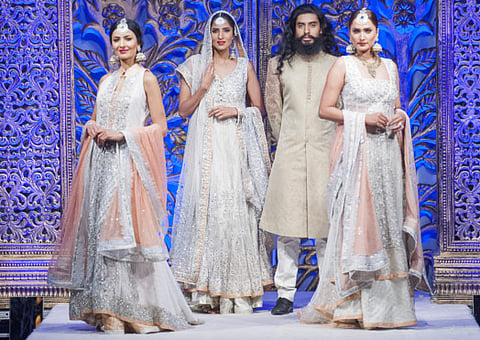Pakistan’s fashion industry comes of age
Local designs make a serious impact on international runways

The setting: Kensington Palace, home of the Duke and Duchess of Cambridge; the event: Fashion Parade 2014; in the spotlight: Pakistani fashion. This June, Fashion Parade showcased Pakistani style among an ensemble of international fashion editors, corporate top brass and the who’s who of the subcontinental diaspora in the UK, proving that Pakistani fashion has truly arrived. A few days earlier, the organisers of Pakistan Fashion Week London (PFWL), Riwayat, debuted Weddings of Asia in London, which showcased the best in Pakistani wedding finery. This was in response to the success of PFWL, which has created the perfect platform for Pakistani designers abroad. “Pakistan fashion has changed tremendously in the past ten years, with a new generation of designers making waves internationally,” says Adnan Ansari, Creative Director, Riwayat. “In the UK specifically, things have evolved dramatically in the past three years. Since we started PFWL in 2011 we have launched almost 120 designers, out of which nearly 90 per cent are now stocking shops all over the UK and Europe.”
This year also saw Alchemy Fashion show, in partnership with the British Council, take place in London’s Southbank Centre. An edgy mix of styles, it focused on Pakistan’s underground urban fashion scene.
Closer to home, April saw the first edition of Pakistan Fashion Week Dubai, promoting the made-in-Pakistan label.
Dr Asma Nina Khan, Director, Pakistan Fashion Week Dubai, says, “This is an exciting time to be part of the country’s fashion scene. There is not only so much talent and creativity, but so much acceptance, support and freedom to take on challenges and push the boundaries of conventional style.”
This month, Faiza Samee, Rizwan Beyg, Sania Maskatiya and Zara Shahjahan will debut at Lakme Fashion Week in Mumbai, India.
A few years ago, the first Pakistan Fashion Design Council Exclusive Store, called PFDC The Boulevard Delhi, opened in an upscale neighbourhood in New Delhi, India. The shop-in-a-shop concept showcasing ready-to-wear bridal couture from Pakistan is doing well, proving that Pakistani sartorial sensibilities have a global appeal, says Anshul Puri, Sales and Communication Manager of the store.
“It’s been three fantastic years so far and we have doubled from two to four shows per event and have almost 20,000 followers on social media,” says Ansari, whose company has been asked to bring the show to Norway, India and France.
Pakistan’s fashion industry is making serious inroads into the world’s fashion scene. Trailblazers such as Sana Safinaz, Deepak Perwani, Maria B., Hassan Sheheryar Yasin and Amir Adnan fought to establish themselves just a few decades ago.
“There was lack of awareness, support, funding and exposure [in the ’90s],” says Khan. But a dramatic shift in attitude, lifestyle and the sociopolitical climate of Pakistan has created an ideal environment for the fashion industry to thrive in.
Fashion blogger Faiza Lakhani of Secret Closet fashion portal, says, “Our industry has come a long way in finding its own voice. Ready-to-wear trends have evoked a sharp move in retail growth, which has naturally led to efficient production, quality and constant influx of creativity.
“Marketing has improved immensely with quality print and digital platforms to create reach and awareness both locally and abroad. The rise of international Pakistani and South Asian fashion weeks, especially in the UK, US, and UAE further allow designers to showcase and penetrate new markets.”
The biggest change has been government support, the launch of fashion weeks and the creation of the Pakistan Fashion Design Council, Khan points out. The Trade Development Authority of Pakistan (TDAP) is heavily invested in educating stakeholders about the industry and regularly participates in international fashion exhibitions such as Interjeans-Cologne, Prêt-a-Porter, Copenhagen International Fashion Fair and Poznan Fashion Week.
Furthermore, TDAP, in collaboration with the Centre for Promotion of Imports from developing countries — the Netherlands, has been organising a series of workshops on the European Union (EU) fashion cycle and fashion forecasts in the EU for exporters and designers in the textile industry.
Designers Deepak Kumar and Fahad Yaqoob launched their label DnF in 2012. They have since participated in numerous shows, four fashion weeks, won the aspiring designer award at Fashion Pakistan Week last year, and enjoyed international exposure at the Pakistan Fashion Week Dubai.
Kumar says, “The Pakistan fashion industry is really coming of age. It is dynamic and youthful, but with an underlined maturity that comes from a strong fraternity, where the older, well-established designers are willing to help and promote the younger generation. There is also tremendous support from fashion councils as well as the media and the government.” New designers such as Mohsin Ali and Maheen Kardar have created stories with garments and incorporated sociopolitical motifs into their designs. This led to a trend during the elections last year when many showed their support for a party by dressing in their signature colours.
The recent launch of online stores by designer Ayesha F Hashwani and retail brands such as Bonanza, Almirah by Junaid Jamshed and Khaadi is another step in promoting Pakistan fashion globally.
One of the first to launch an e-store was Pakistani brand Labels two years ago. Ansari also promises to launch the Riwayat Designer’s Studio next month, “where it will be possible to buy and order bespoke outfits from our range of designers, whether ready-to-wear, luxury or formal”.
Active media participation, investing in emerging talent, viewing designers as brand ambassadors, promoting Pakistan globally and the industry coming together are some of the other factors shaping the sector’s positive image.
Sign up for the Daily Briefing
Get the latest news and updates straight to your inbox



